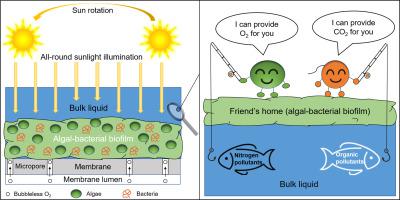Science of the Total Environment ( IF 8.2 ) Pub Date : 2022-08-15 , DOI: 10.1016/j.scitotenv.2022.158063 Jibin Li 1 , Rui Ou 1 , Huaiyu Liao 1 , Jinxing Ma 2 , Li Sun 3 , Qinghai Jin 4 , Di He 2 , Qilin Wang 5

|
Membrane-aerated bacterial-algal biofilm reactor (MABAR) is an emerging and novel technology in recent years, which has been attracting increasing attention due to its cost-effectiveness and superior removal performance of pollutants by versatile removal pathways in symbiotic bacterial-algal biofilm. However, the wider application of MABAR is hindered by the dilemma of insufficient algae biomass. In this study, an MABAR under natural sunlight was developed and operated for 160 d to access the feasibility of enhancing algae proliferation by natural lighting. Results showed that the MABAR with natural sunlight (nMABAR) demonstrated better performance of pollutants removal. High removal efficiencies of organic matter and NH4-N in nMABAR were 90 % and 92 %, respectively. In particular, the removal efficiency of TN in nMABAR, under less aeration, was up to 80 %, which was 15 % higher than the control reactor. The Chlorophyll-a content indicated that natural sunlight facilitated to algae growth in MABAR, and algae assimilation might be the dominant contributor to NH4-N removal. Moreover, there were microbial shifts in bacterial-algal biofilm in a response to the natural lighting, the nMABAR uniquely possessed a bacterial phylotype termed Thiocapsa, which could play an important role in bacterial nitrification. Algal phylotype Chlorophyceae significantly contributed to pollutants removal and synergistic relationship with bacteria. In addition, the superb performance of nMABAR under less aeration condition suggested that abundant algae were capable of supplying enough O2 for the system. These results provided insight into the natural lighting on algae-bacteria synergistic growth and cost-effective operation strategy for MABAR.
中文翻译:

自然光照促进膜曝气菌藻生物膜反应器中藻类增殖和脱氮
膜曝气菌藻生物膜反应器(MABAR)是近年来新兴的新技术,由于其成本效益和通过共生菌藻生物膜中多种去除途径对污染物的优异去除性能而受到越来越多的关注。然而,藻类生物量不足的困境阻碍了 MABAR 的更广泛应用。在本研究中,开发了一种自然光下的 MABAR,并运行了 160 d,以获得通过自然光促进藻类增殖的可行性。结果表明,自然阳光下的 MABAR (nMABAR) 表现出更好的污染物去除性能。有机物和NH 4的去除效率高nMABAR 中的 -N 分别为 90 % 和 92 %。特别是,在较少曝气条件下,nMABAR 中 TN 的去除效率高达 80%,比对照反应器高 15%。叶绿素a含量表明自然阳光促进了MABAR中藻类的生长,藻类同化可能是NH 4 -N去除的主要贡献者。此外,细菌-藻类生物膜中的微生物在对自然光照的反应中发生了变化,nMABAR 独特地拥有一种称为Thiocapsa的细菌系统发育型,它可以在细菌硝化中发挥重要作用。藻类系统型绿藻科显着促进污染物去除和与细菌的协同关系。此外,nMABAR 在较少曝气条件下的卓越性能表明,丰富的藻类能够为系统提供足够的 O 2。这些结果为了解自然光照对藻细菌协同生长和 MABAR 的成本效益操作策略提供了见解。






























 京公网安备 11010802027423号
京公网安备 11010802027423号